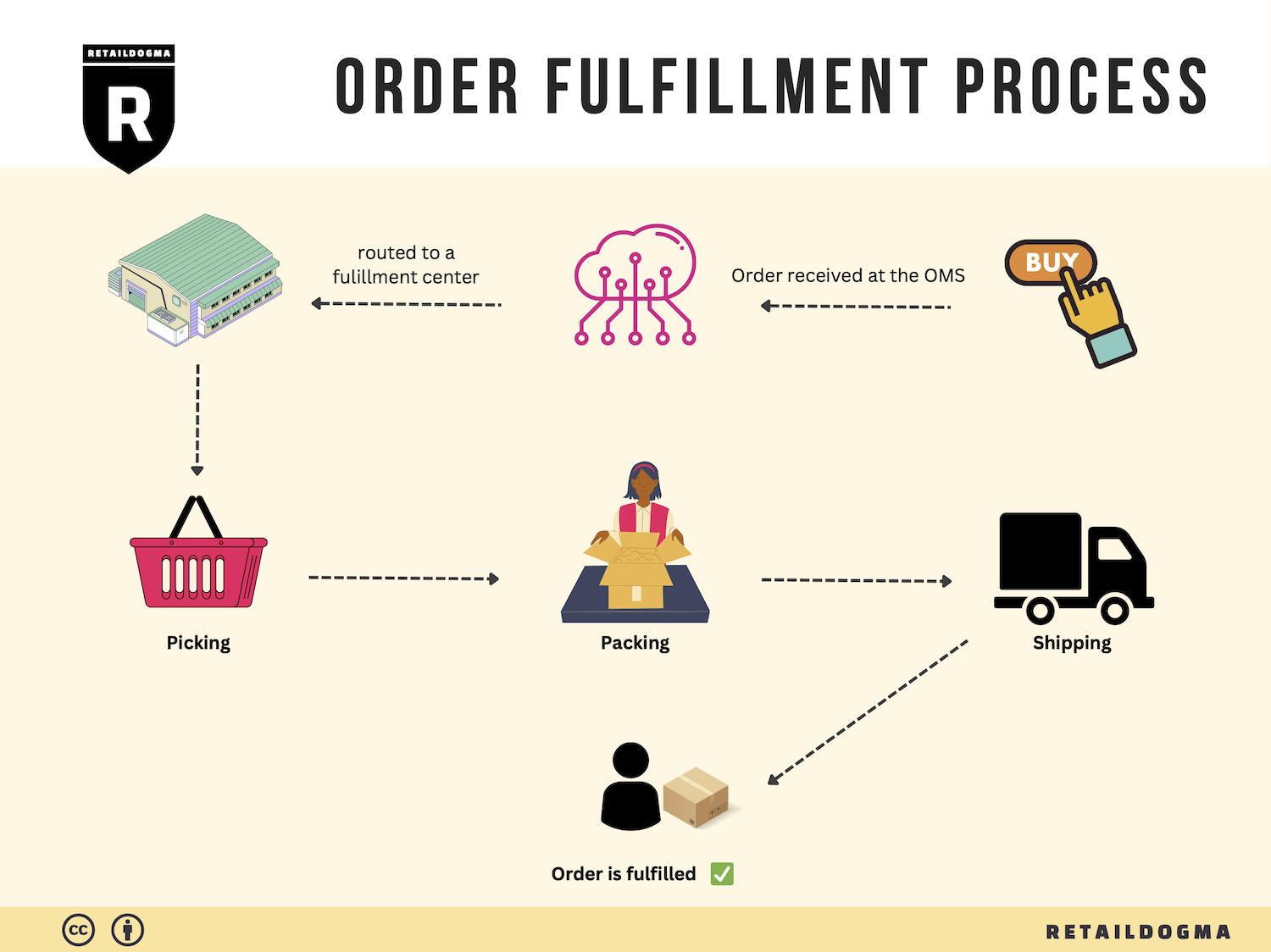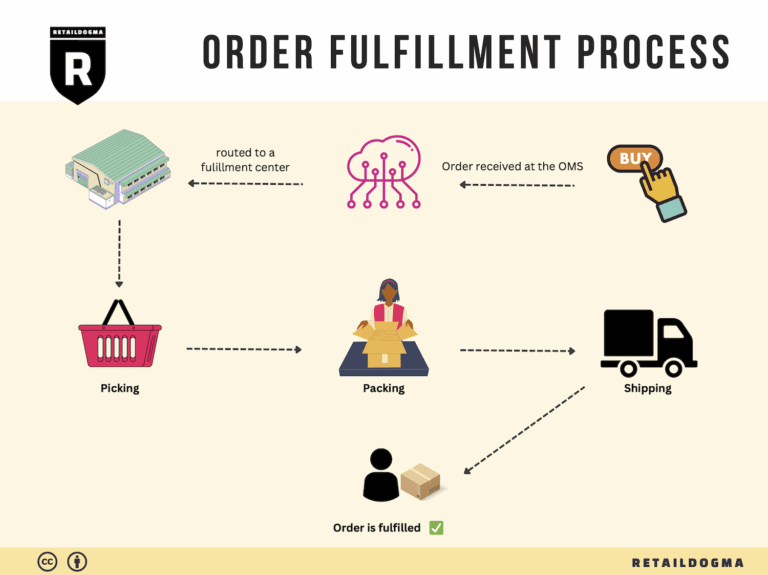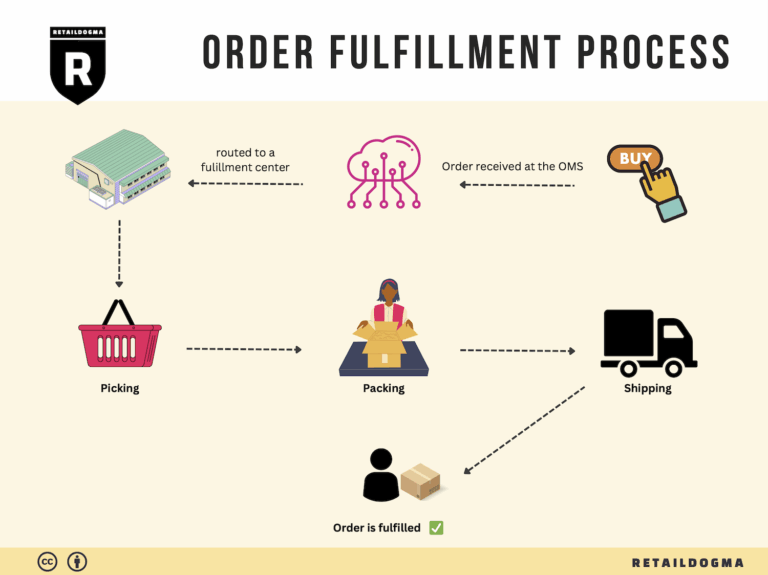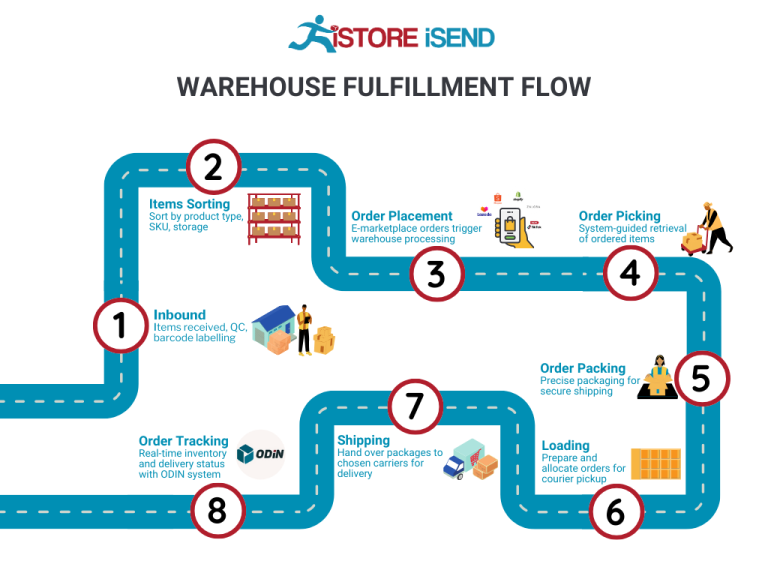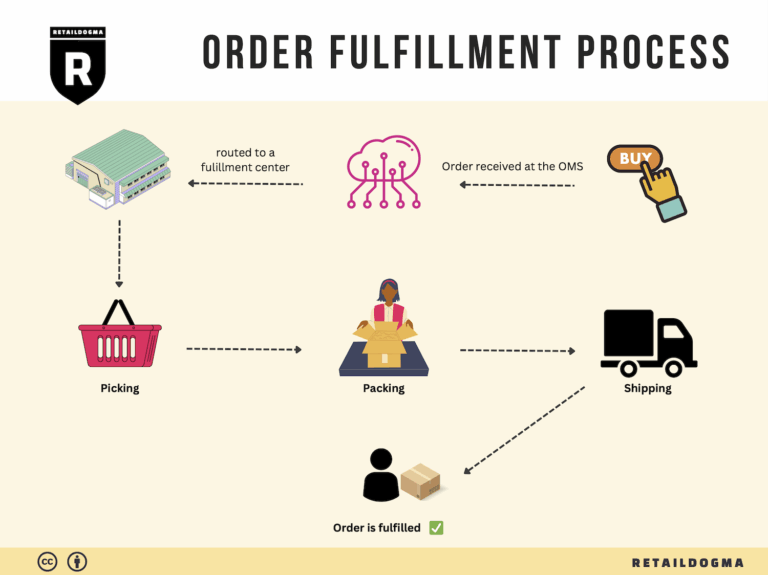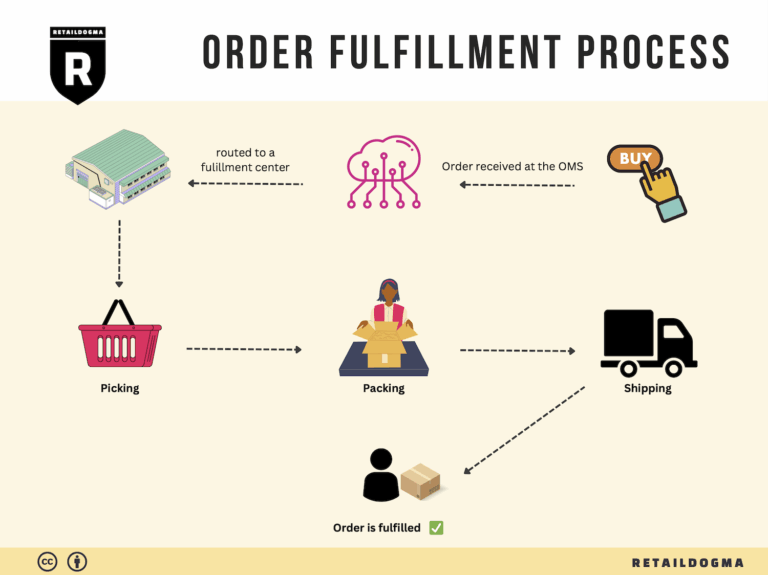What Is A Fulfillment Center? A Complete Guide (2025)
What is E-commerce Fulfillment? An Introduction for Growing Businesses
Growing an online business can be incredibly rewarding, but it often comes with its fair share of challenges. One of the most common pain points for e-commerce entrepreneurs is the overwhelming task of packing and shipping orders. As sales increase, so does the complexity of logistics, leading many businesses to feel stretched thin. This is where understanding e-commerce fulfillment becomes crucial.
Fulfillment can be defined simply as the process of getting a product from your inventory to your customer’s doorstep. It encompasses various steps, including inventory management, order processing, packing, shipping, and handling returns. For many growing businesses, managing fulfillment in-house can quickly become a bottleneck, diverting valuable time and resources away from core business functions like marketing and product development.
In this guide, we will delve into the different models of e-commerce fulfillment available to businesses today. We’ll explore traditional options such as Third-Party Logistics (3PL) providers and Fulfillment by Amazon (FBA), as well as newer solutions like Fulfilled by TikTok (FBT). Each model has its own set of advantages and disadvantages, and understanding these nuances will help you make informed decisions as your business scales.
We will also outline the core services that fulfillment partners typically offer, such as warehousing, picking and packing, shipping logistics, and customer service support. Knowing what to expect from a fulfillment partner can streamline your operations and improve your customer experience.
Choosing the right fulfillment partner is pivotal for your business’s success. We’ll provide practical tips on how to evaluate potential partners based on their capabilities, technology, scalability, and pricing. Understanding the cost structures associated with different fulfillment models will empower you to make decisions that align with your budget and growth goals.
Ultimately, this guide aims to equip you with the knowledge and tools necessary to make smart, strategic decisions about your logistics. By optimizing your fulfillment processes, you can focus more on what you do best—growing your business and delighting your customers.
What You’ll Learn In This Guide
- What is E-commerce Fulfillment? An Introduction for Growing Businesses
- The Order Fulfillment Process: From ‘Buy’ Button to Customer’s Door
- Comparing Fulfillment Models: In-House vs. 3PL vs. Dropshipping
- A Deep Dive into Amazon FBA: Pros, Cons, and Who It’s For
- Core Services Offered by Fulfillment Centers
- How to Choose a Fulfillment Partner: A 6-Point Checklist
- Understanding Fulfillment Pricing: A Breakdown of Common Fees
- Frequently Asked Questions (FAQs) about Fulfillment
- Conclusion: Is Outsourcing Fulfillment the Right Move for Your Business?
- Important Disclaimer
The Order Fulfillment Process: From ‘Buy’ Button to Customer’s Door
1. Receiving Inventory
The order fulfillment process begins with the receiving of inventory. This step involves the arrival of products at the fulfillment center or warehouse where they will be stored before being shipped out. During this phase, inventory is checked against purchase orders to ensure accuracy in quantity and quality.
Importance: Proper receiving is crucial because it sets the foundation for the entire fulfillment process. Any discrepancies at this stage can lead to stockouts or overstock situations, which can negatively impact sales and customer satisfaction.
Key Term: SKU (Stock Keeping Unit) – A unique identifier assigned to each product that facilitates efficient tracking and inventory management. Ensuring that each SKU is accurately logged upon receiving helps maintain a seamless inventory flow.
2. Warehouse Storage
Once the inventory is received and verified, it is then moved to warehouse storage. Products are organized in a systematic manner, often utilizing shelving units, bins, or pallets based on size, type, or sales velocity.
Importance: Effective warehouse storage is essential for maximizing space and ensuring easy access to products. A well-organized warehouse reduces the time needed to locate items, which is critical when fulfilling orders quickly.
Key Term: ABC Analysis – A method used to categorize inventory based on importance, where ‘A’ items are high-value products with low sales frequency, ‘B’ items are moderate in both value and frequency, and ‘C’ items are low-value but high-frequency products. This categorization helps optimize storage strategies and improve picking efficiency.
3. Order Picking
The next step is order picking, where items are retrieved from their storage locations based on customer orders. Workers utilize pick lists, which detail the specific SKUs and quantities needed for each order.
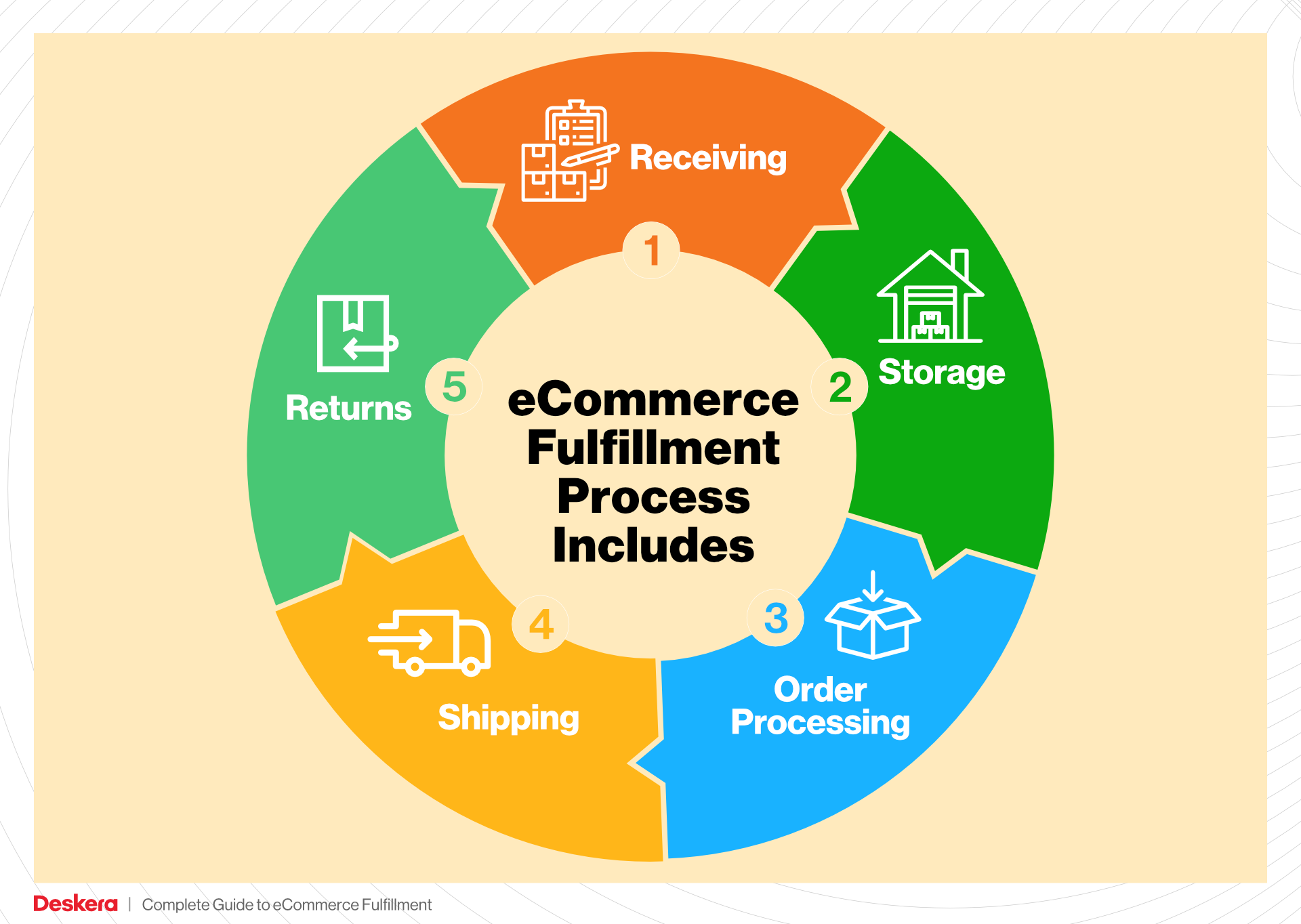
Importance: Order picking is one of the most labor-intensive steps in the fulfillment process. Efficiency in this stage is vital as it directly impacts shipping times and customer satisfaction. Errors in picking can lead to incorrect orders, resulting in returns and a poor customer experience.
Key Term: Pick Lists – Documents or digital lists generated from the order management system that guide warehouse staff in selecting the correct items for fulfillment. Optimizing pick lists can streamline the picking process and reduce labor costs.
4. Order Packing
After picking, the next step is order packing, where items are prepared for shipment. This involves placing the picked products into appropriate packaging, adding any necessary documentation (like invoices or return labels), and ensuring that items are secure to prevent damage during transit.
Importance: Proper packing is essential for protecting products and ensuring they arrive safely at the customer’s location. It also plays a significant role in the customer’s unboxing experience, which can influence future purchase decisions.
Key Term: Packaging Materials – Supplies such as boxes, bubble wrap, and packing peanuts used to secure items during shipping. Choosing the right materials can reduce shipping costs and enhance product protection.
5. Shipping & Delivery
The final step is shipping and delivery, where packed orders are handed over to shipping carriers for transportation to the customer’s address. This phase involves creating shipping labels, scheduling pickups, and tracking shipments until they reach the customer.
Importance: Timely shipping and delivery are critical for maintaining customer satisfaction and loyalty. Delays can lead to negative reviews and decreased repeat business. Moreover, efficient shipping processes can also reduce costs and improve profit margins.
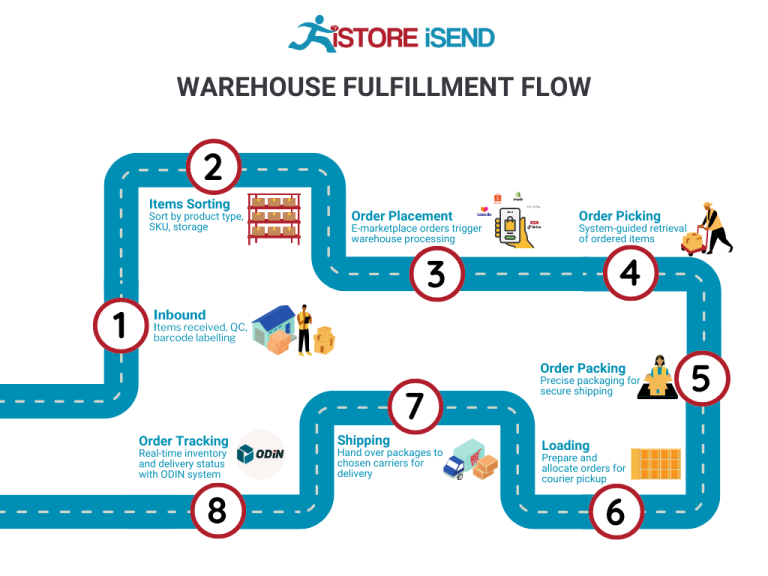
Key Term: Last-Mile Delivery – The final step in the delivery process where the package is transported from a distribution center to the end customer’s doorstep. Optimizing last-mile delivery is key to ensuring timely and cost-effective shipping.
By understanding each step of the order fulfillment process, e-commerce businesses can better strategize their operations to enhance efficiency, reduce costs, and ultimately improve customer satisfaction. Leveraging solutions like Fulfilled by TikTok can help streamline these processes, allowing businesses to focus on growth and customer engagement.
Comparing Fulfillment Models: In-House vs. 3PL vs. Dropshipping
Fulfillment Model Comparison
| Model | Who Handles Inventory | Best For (Business Stage) | Key Advantage | Key Disadvantage |
|---|---|---|---|---|
| In-House Fulfillment | The Business Itself | Established businesses with stable demand | Full control over operations and inventory | High overhead costs and resource strain |
| Third-Party Logistics (3PL) | 3PL Provider | Growing businesses looking to scale | Reduced operational burden | Less control over fulfillment processes |
| Dropshipping | Supplier/Manufacturer | Startups or businesses testing new products | Low upfront investment | Lower profit margins and potential delays |
In-House Fulfillment
In-house fulfillment involves managing all aspects of the storage, picking, packing, and shipping processes within your own facilities. This model is best suited for established businesses that have a stable demand and sufficient resources to handle fulfillment operations. The key advantage of in-house fulfillment is the complete control it provides over inventory management, quality assurance, and customer service. Businesses can tailor their fulfillment processes to meet specific needs, ensuring a personalized experience for customers. However, the primary disadvantage lies in the high overhead costs associated with maintaining inventory, staffing a warehouse, and managing logistics. This model can strain resources, particularly during peak seasons or unexpected surges in demand, making it less scalable without significant investment.
Third-Party Logistics (3PL)
Third-party logistics (3PL) is a fulfillment model where businesses outsource their logistics and supply chain management to specialized providers. This approach is particularly advantageous for growing businesses that are looking to scale operations without the burden of managing their own warehousing and shipping processes. A key advantage of using a 3PL provider is the reduction in operational burdens; businesses can focus on core activities like marketing and product development while relying on the 3PL to handle storage, order fulfillment, and shipping. Additionally, 3PLs often have established networks and technology that can enhance shipping speed and efficiency. However, the trade-off is a loss of control over the fulfillment process, which can lead to inconsistencies in service quality and customer experience. Businesses must carefully choose their 3PL partners to ensure alignment with their operational standards and customer expectations.
Dropshipping
Dropshipping is a fulfillment method where the retailer does not keep products in stock but instead transfers customer orders to a supplier, who then ships the products directly to the customer. This model is particularly appealing to startups or businesses testing new products, as it requires minimal upfront investment and eliminates the need for inventory management. The primary advantage of dropshipping is the low financial risk involved; businesses can offer a wide range of products without the need for significant capital tied up in inventory. However, the key disadvantage of dropshipping is typically lower profit margins due to reliance on suppliers for fulfillment, and there can be delays in shipping times, which may affect customer satisfaction. Additionally, businesses have limited control over product quality and fulfillment processes, making it crucial to partner with reliable suppliers to mitigate these risks.
Conclusion
When choosing a fulfillment model, it’s essential for e-commerce businesses to consider their current stage, operational capabilities, and long-term growth goals. In-house fulfillment offers control and quality assurance, making it suitable for established brands, while 3PL provides scalability and operational efficiency for growing businesses. Dropshipping serves as a low-risk entry point for startups, but it comes with challenges that require careful supplier management. By understanding the strengths and weaknesses of each model, business owners can make informed decisions that align with their strategic objectives and enhance their fulfillment capabilities on platforms like TikTok Shop.
A Deep Dive into Amazon FBA: Pros, Cons, and Who It’s For
Understanding Fulfillment by Amazon (FBA)
Fulfillment by Amazon (FBA) is a service that allows e-commerce sellers to store their products in Amazon’s fulfillment centers. Amazon then takes care of storage, packaging, shipping, and customer service on behalf of the sellers. This means that when a customer places an order, Amazon picks, packs, and ships the item directly to the customer. Sellers can also benefit from Amazon’s extensive logistics network, ensuring fast delivery and customer satisfaction.
How FBA Works
-
Account Setup: Sellers create an Amazon Seller account and enroll in the FBA program.
-
Inventory Preparation: Sellers prepare their products according to Amazon’s guidelines, which include labeling and packaging requirements.
-
Shipping to Amazon: Once the products are prepared, sellers ship their inventory to Amazon’s fulfillment centers. Amazon provides shipping plans and guidelines to help sellers navigate this process.
-
Storage: The products are stored in Amazon’s warehouses until they are sold. Sellers can monitor their inventory levels through the Seller Central dashboard.
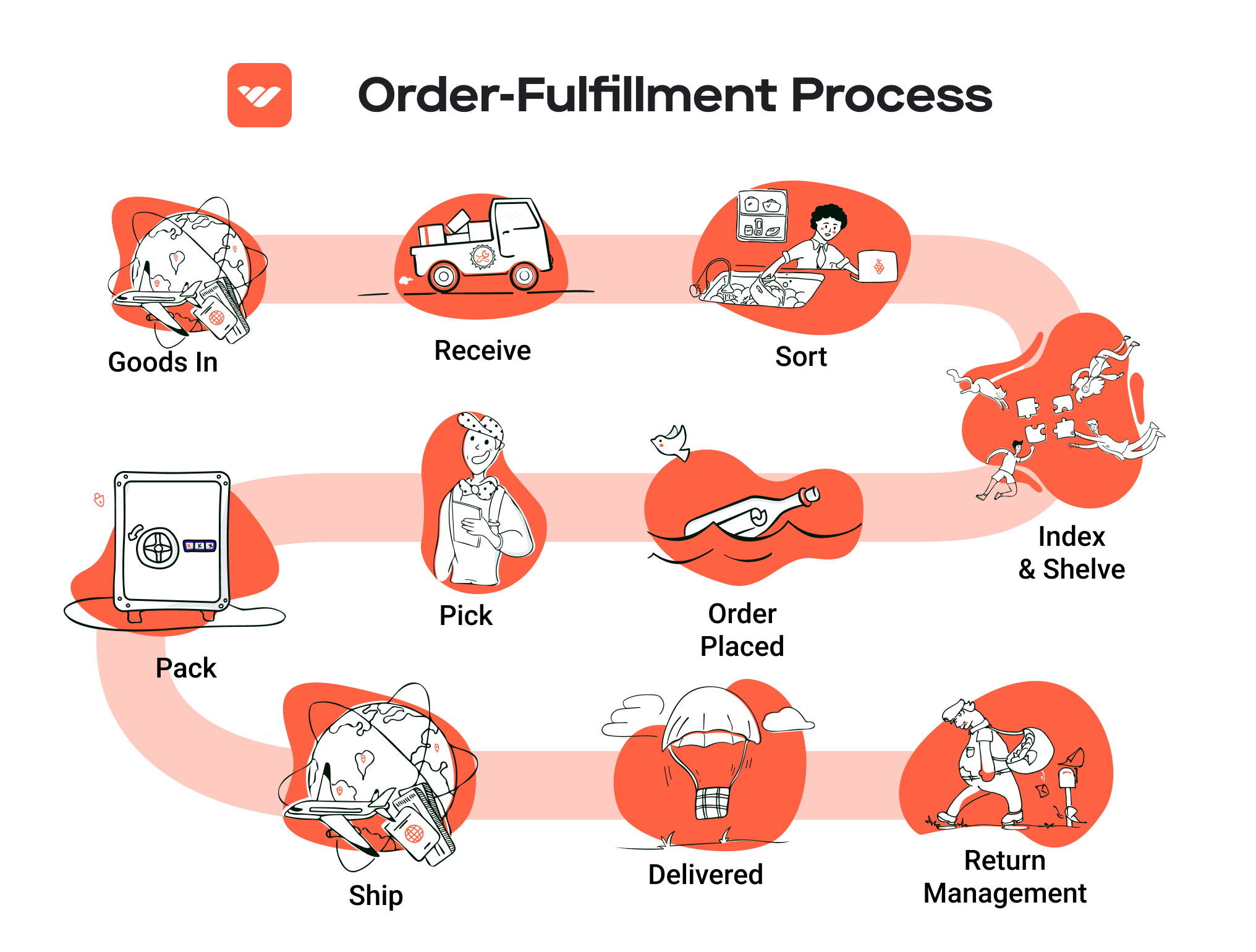
-
Order Processing: When a customer places an order, Amazon handles the entire fulfillment process. This includes picking the product from the shelf, packing it securely, and shipping it to the customer.
-
Customer Service: Amazon manages customer service inquiries related to FBA orders, including returns and refunds.
-
Payment: After the order is fulfilled, Amazon processes the payment and transfers the proceeds to the seller, minus applicable fees.
Pros of Fulfillment by Amazon
Prime Eligibility
One of the standout benefits of FBA is that products fulfilled by Amazon are eligible for Amazon Prime. This means that Prime members can enjoy free two-day shipping on these items, which can significantly increase sales. Prime members tend to spend more than non-members, making this a valuable advantage.
Customer Trust
Amazon is a trusted name in e-commerce. By using FBA, sellers can leverage Amazon’s brand reputation, which can lead to increased customer confidence in purchasing from their listings. Customers often prefer products that are fulfilled by Amazon due to the assurance of reliable shipping and customer service.
Multi-Channel Fulfillment
FBA isn’t limited to just Amazon.com. Sellers can also use FBA to fulfill orders from other sales channels, such as their own websites or other marketplaces. This flexibility allows businesses to streamline their logistics operations and maintain a consistent customer experience across platforms.
Cons of Fulfillment by Amazon
High Fees
While FBA offers numerous benefits, it also comes with significant costs. Sellers are charged for storage space and fulfillment services, which can add up quickly. Monthly storage fees are applied for inventory stored in Amazon’s warehouses, and fulfillment fees are charged per unit sold. These fees can be particularly burdensome for small businesses or those selling low-margin products.
Strict Inventory Rules
Amazon has stringent policies regarding inventory management. Sellers must adhere to specific guidelines related to labeling, packaging, and inventory limits. Failing to comply can lead to additional charges or even the suspension of selling privileges. This can create challenges for sellers who are not well-versed in Amazon’s policies.
Commingling Risks
When sellers use FBA, their products may be stored alongside those of other sellers in Amazon’s warehouses. This commingling can lead to issues if items are damaged or if there are discrepancies in inventory. For example, if a seller’s product is damaged and replaced with a different seller’s product, it can lead to negative customer experiences and potential brand damage.
Who is FBA Best For?
Fulfillment by Amazon is particularly well-suited for:
-
Small to Medium-Sized Businesses: Companies that lack the resources to manage their own fulfillment operations can benefit from FBA’s logistics support.
-
High-Volume Sellers: Businesses that have a consistent and high volume of sales can take advantage of the economies of scale that FBA offers, helping to lower their overall fulfillment costs.
-
New Sellers: Entrepreneurs who are just starting out can leverage FBA to quickly establish a presence on Amazon without needing to invest heavily in logistics infrastructure.
-
Sellers of Seasonal or Trendy Products: Businesses that experience spikes in demand during certain seasons or trends can use FBA to efficiently manage inventory without the need for extensive warehousing.
In conclusion, while Fulfillment by Amazon presents numerous advantages for e-commerce sellers, it also comes with notable challenges. Businesses must carefully evaluate their product types, sales volumes, and operational capabilities before deciding to utilize FBA. By understanding both the pros and cons, sellers can make informed decisions that align with their growth strategies and operational needs.
Core Services Offered by Fulfillment Centers
Inventory Management & Warehousing
Inventory management and warehousing are foundational services provided by fulfillment centers that play a crucial role in the e-commerce supply chain. This service involves the systematic tracking of inventory levels, orders, sales, and deliveries. Fulfillment centers utilize sophisticated inventory management systems that offer real-time data on stock levels, enabling businesses to maintain optimal inventory without overstocking or stockouts.
Benefits:
-
Efficient Stock Control: By outsourcing inventory management, e-commerce businesses can benefit from advanced tracking technologies that minimize errors and enhance accuracy in stock levels. This allows for better forecasting and ensures that products are available when customers demand them.
-
Scalability: As businesses grow, their inventory needs change. Fulfillment centers offer flexible warehousing solutions that can scale according to seasonal demands or sudden surges in order volume, such as during promotions or viral trends on platforms like TikTok.
-
Cost Savings: Utilizing a fulfillment center’s warehousing capabilities can reduce overhead costs associated with maintaining an in-house warehouse, including rent, utilities, and labor. This allows businesses to allocate resources more effectively toward marketing and product development.
Pick and Pack Services
Pick and pack services are essential for e-commerce fulfillment, where items are retrieved from the warehouse (picked) and packaged for shipment (packed). Fulfillment centers employ trained staff and automated systems to efficiently fulfill these tasks, ensuring that orders are prepared accurately and quickly.
Benefits:
-
Speed and Accuracy: With dedicated teams and streamlined processes, fulfillment centers can significantly reduce the time it takes to pick and pack orders. This leads to faster shipping times, enhancing customer satisfaction and increasing the likelihood of repeat purchases.
-
Customization Options: Many fulfillment centers offer customizable packaging solutions, allowing businesses to enhance their brand presence. Custom packaging can create a memorable unboxing experience, which is crucial in a competitive e-commerce landscape.
-
Error Reduction: Advanced technology, including barcode scanning and inventory management software, helps minimize picking errors. This reduces the incidence of returns due to incorrect items being sent, ultimately saving time and costs associated with processing returns.
Kitting and Assembly
Kitting and assembly services involve grouping multiple items into a single package or assembling products before they are shipped. This service is particularly valuable for businesses that sell bundles, gift sets, or complex products that require assembly.
Benefits:
-
Enhanced Product Offering: By offering kitted products, e-commerce businesses can create unique value propositions that attract customers. For example, bundling complementary products can increase average order value and improve customer satisfaction.
-
Efficiency in Shipping: Kitting reduces the complexity of order fulfillment by allowing multiple items to be shipped together. This not only streamlines the shipping process but also reduces shipping costs, as it minimizes the number of individual packages sent out.
-
Faster Time to Market: When a fulfillment center handles kitting and assembly, businesses can quickly respond to market demands and trends. This agility allows them to introduce new products or bundles without the need for extensive in-house resources.
Returns Management (Reverse Logistics)
Returns management, or reverse logistics, is a critical service offered by fulfillment centers that deals with the process of handling returns from customers. This includes receiving returned items, inspecting them, restocking, or processing them for refurbishment or disposal.
Benefits:
-
Streamlined Returns Process: A dedicated returns management system simplifies the return process for customers, making it easy for them to return items. This convenience can improve customer satisfaction and loyalty, even in cases of product dissatisfaction.
-
Cost Recovery: Effective returns management allows businesses to recover value from returned items. Fulfillment centers can assess the condition of returned products and determine the best course of action, whether it be restocking, refurbishing, or recycling.
-
Data Insights: Analyzing return data can provide valuable insights into product performance, customer preferences, and potential quality issues. This information can inform product development and marketing strategies, ultimately leading to improved offerings and reduced return rates.
In summary, partnering with a fulfillment center for core services such as inventory management, pick and pack, kitting, and returns management can significantly enhance an e-commerce business’s operational efficiency and customer satisfaction. By leveraging these services, businesses can focus on growth and innovation while ensuring their logistics processes are optimized for success.
How to Choose a Fulfillment Partner: A 6-Point Checklist
Location & Warehouse Network
Importance:
The geographical location of your fulfillment partner’s warehouses plays a crucial role in shipping efficiency and delivery times. A partner with strategically located warehouses can significantly reduce shipping costs and lead times, enhancing the customer experience.
Questions to Ask:
– Where are your warehouses located, and how does this align with my target market?
– What is your average shipping time to major metropolitan areas?
– Do you have the ability to open additional warehouses if my business grows?
Technology & Integrations
Importance:
In the digital age, having a technologically advanced fulfillment partner is essential. Their systems should integrate seamlessly with your e-commerce platform to streamline order processing, inventory management, and shipping. This can lead to reduced errors and faster order fulfillment.
Questions to Ask:
– What technology do you use for inventory management and order processing?
– Can your systems integrate with popular e-commerce platforms like Shopify, WooCommerce, or TikTok Shop?
– How do you handle real-time inventory updates, and can I access this data?
Specializations (e.g., cold storage, oversized items)
Importance:
Not all fulfillment partners can handle every type of product. If you sell specialized items, such as perishables or oversized goods, it’s essential to choose a partner with the expertise and facilities to manage these products appropriately.
Questions to Ask:
– Do you have experience handling my specific product types?
– What specialized services do you offer, such as cold storage or hazardous materials handling?
– Can you accommodate unique packaging requirements for my products?
Scalability & Capacity
Importance:
As your business grows, so will your fulfillment needs. A partner that can scale with you is vital to avoid disruptions in service. You want to ensure that your fulfillment partner can handle increased order volumes without compromising on service quality.
Questions to Ask:
– How do you manage seasonal spikes in demand?
– What is your current capacity, and how easily can you scale?
– Can you provide examples of how you have supported other clients during periods of rapid growth?
Pricing and Contracts
Importance:
Understanding the pricing structure and contract terms is crucial for budgeting and financial planning. Look for transparency in costs and flexibility in contract terms to avoid long-term commitments that may not serve your evolving business needs.
Questions to Ask:
– What is your pricing model (e.g., per order, weight-based, storage fees)?
– Are there any hidden fees I should be aware of?
– What are the terms for contract termination or renegotiation?
Customer Support & Reviews
Importance:
Effective customer support can be a game-changer when dealing with fulfillment issues. A responsive partner can help resolve problems quickly, minimizing the impact on your business. Additionally, reviews from other clients can provide insights into the partner’s reliability and service quality.
Questions to Ask:
– What customer support options do you offer (e.g., phone, email, chat)?
– Can you provide references or case studies from similar businesses?
– How do you handle fulfillment errors or issues with orders?
Conclusion
Choosing the right fulfillment partner is a critical decision that can impact your e-commerce business’s efficiency and customer satisfaction. By using this checklist, you can make an informed choice that aligns with your business goals and customer expectations. Each of these factors plays a pivotal role in ensuring that your fulfillment operations run smoothly, allowing you to focus on scaling your sales and enhancing your brand presence, especially on platforms like TikTok Shop.
Understanding Fulfillment Pricing: A Breakdown of Common Fees
Initial Setup Fees
When partnering with a fulfillment service like Fulfilled by TikTok (FBT), many providers charge an initial setup fee. This fee typically covers the costs associated with integrating your systems with theirs, establishing your account, and preparing your inventory for storage. The setup fee may vary based on the complexity of your operations and the specific requirements of your business. For instance, if you have a large catalog of items or need custom solutions, the setup fee might be higher.
To calculate the setup fee, fulfillment centers may consider factors such as:
- Integration Complexity: The time and resources needed to connect your inventory management system with their platform.
- Inventory Volume: The amount of inventory being sent to the fulfillment center, as larger volumes may require more extensive setup.
- Custom Solutions: Any additional services or customizations that you may require to optimize your fulfillment process.
Receiving Fees
Receiving fees are charged when your products arrive at the fulfillment center. This fee compensates the facility for the labor and resources required to unload, inspect, and store your inventory. The cost can vary based on the volume and type of goods received.
Receiving fees are typically calculated based on:
- Per Unit Basis: A standard charge per item received.
- Pallet or Bin Basis: A fee based on the number of pallets or bins received, which may be more applicable for bulk shipments.
Understanding how the receiving process works and what specific fees apply can help you budget more accurately.
Storage Fees (per pallet/bin)
Storage fees are charged for the space your inventory occupies within the fulfillment center. These fees can be structured either on a per-pallet or per-bin basis, depending on how your items are organized and stored.
Common factors influencing storage fees include:
- Duration of Storage: Many fulfillment centers charge a monthly fee based on how long your inventory is stored. Longer storage times can result in higher costs.
- Type of Storage: Specialized storage conditions (like climate control) may incur additional fees.
- Volume of Inventory: A higher volume of inventory will naturally lead to increased storage fees, so understanding your inventory turnover rates is crucial to managing costs effectively.
Pick & Pack Fees (per item/order)
Pick and pack fees are charged for the labor involved in retrieving items from the warehouse and preparing them for shipment. This fee is often calculated on a per-item basis, which means the more items in an order, the higher the fee.
Key considerations for pick and pack fees include:
- Per Item Fee: A fixed charge for each item picked and packed.
- Order Complexity: If an order requires special handling (like custom packaging or kitting), additional fees may apply.
- Volume Discounts: Some fulfillment centers offer discounted rates for businesses with high order volumes, which can significantly lower your overall costs.
Shipping Fees
Shipping fees encompass the costs associated with delivering your products to customers. These fees can vary widely based on factors such as the destination, shipping speed, and the carrier used.
Shipping fees are typically calculated based on:
- Weight and Dimensions: The weight and size of the package can significantly affect shipping costs, as carriers often use dimensional weight pricing.
- Shipping Method: Different service levels (standard, expedited, overnight) come with varying costs.
- Destination: Shipping within the same region is usually cheaper than shipping internationally or to remote areas.
Tips for Getting an Accurate Quote
To ensure you receive an accurate quote for fulfillment services, consider the following tips:
-
Provide Detailed Information: Clearly communicate your inventory size, types of products, and expected order volumes. The more detailed your information, the more accurate the quote will be.
-
Inquire About Hidden Fees: Ask about any potential additional fees that may not be included in the initial quote, such as fees for returns or special handling.
-
Compare Multiple Providers: Don’t settle for the first quote you receive. Compare offers from different fulfillment partners to find one that meets your needs and budget.
-
Request a Breakdown of Costs: Ask for a detailed breakdown of all fees associated with their services. This transparency helps you understand where your money is going and allows for better financial planning.
-
Review Terms and Conditions: Carefully read the terms of service to avoid unexpected charges later. Understanding the fine print can save you from unforeseen costs down the line.
By grasping the common fulfillment pricing models and following these tips, e-commerce businesses can make informed decisions that support their growth and efficiency as they scale their operations.
Frequently Asked Questions (FAQs) about Fulfillment
1. What is Fulfilled by TikTok (FBT)?
Fulfilled by TikTok (FBT) is a fulfillment service offered by TikTok that allows e-commerce merchants to outsource their order fulfillment process. TikTok manages the storage, picking, packing, and shipping of products sold through TikTok Shop, enabling sellers to focus on other aspects of their business.
2. How does Fulfilled by TikTok work?
Once you sign up for FBT, you send your inventory to TikTok’s fulfillment partners, like ShipBob. When a customer places an order through your TikTok Shop, TikTok handles the picking, packing, and shipping of the product directly to the customer, ensuring fast and reliable delivery.
3. What are the benefits of using Fulfilled by TikTok?
Using FBT provides several advantages, including reduced fulfillment costs, faster delivery times, and improved customer service. TikTok also manages shipping inquiries, allowing you to allocate your resources to other business areas. Additionally, you can benefit from subsidized storage and shipping rates.
4. What is the difference between a warehouse and a fulfillment center?
A warehouse is primarily a storage space for inventory, while a fulfillment center is designed specifically for processing and shipping orders. Fulfillment centers are equipped with technology and staff to handle order picking, packing, and shipping efficiently, which is critical for e-commerce operations.
5. What is a 3PL (Third-Party Logistics)?
A Third-Party Logistics (3PL) provider is a company that offers outsourced logistics services, including storage, inventory management, order fulfillment, and shipping. Businesses often partner with 3PLs to streamline their operations and reduce the burden of managing logistics in-house.
6. How much do fulfillment services cost?
The cost of fulfillment services can vary widely based on factors such as storage fees, order processing fees, shipping rates, and additional services like packaging. For FBT, TikTok offers subsidized rates, which can help reduce overall fulfillment costs. It’s essential to analyze your specific needs and compare various providers to find the best solution for your business.
7. Can I fulfill TikTok Shop orders myself?
Yes, you can fulfill TikTok Shop orders independently, a process known as self-fulfillment. In this case, you will handle inventory storage, order packing, and shipping logistics. TikTok provides the necessary shipping labels, but this option requires more resources and time on your part.
8. What types of products can I sell through TikTok Shop?
You can sell a wide range of products through TikTok Shop, provided they comply with TikTok’s community guidelines and policies. This includes fashion, beauty, home goods, electronics, and more. It’s essential to ensure that your products meet all regulatory requirements before listing them on the platform.
9. How can I optimize my fulfillment process on TikTok?
To optimize your fulfillment process on TikTok, consider using FBT to streamline operations and reduce handling time. Additionally, monitor your inventory levels closely to avoid stockouts, use analytics to understand customer demand, and leverage TikTok’s promotional tools to drive sales effectively.
10. What should I do if I encounter issues with order fulfillment?
If you experience issues with order fulfillment, first reach out to TikTok’s support team for assistance. If you’re using FBT, they handle customer service inquiries related to shipping. For self-fulfillment or other logistics partners, ensure you have a clear communication plan in place to address issues quickly and maintain customer satisfaction.
Conclusion: Is Outsourcing Fulfillment the Right Move for Your Business?
Evaluating the Benefits of Outsourcing Fulfillment
Outsourcing fulfillment can be a game-changer for e-commerce businesses looking to scale operations efficiently. By leveraging a dedicated fulfillment service like Fulfilled by TikTok (FBT), businesses can save significant time and resources. Instead of managing the complexities of inventory storage, order picking, packing, and shipping, your team can focus on what truly matters—growing your brand and enhancing customer engagement.
In addition to time savings, outsourcing fulfillment provides a scalable solution. As your sales volume increases, especially during viral trends on platforms like TikTok, a fulfillment partner can adapt quickly to meet rising demand without overwhelming your existing infrastructure. This flexibility allows you to seize growth opportunities without the stress of managing logistics.
Moreover, partnering with an expert fulfillment service means you gain access to specialized knowledge and technology that can enhance your operational efficiency. Experienced fulfillment providers often have sophisticated systems in place to optimize shipping routes, reduce lead times, and improve overall customer satisfaction. This expertise translates into better performance metrics, such as on-time deliveries and lower late dispatch rates, ultimately enhancing your brand’s reputation.
However, choosing the right fulfillment partner is critical. It’s essential to evaluate potential partners not just on cost, but also on their reliability, scalability, and the specific benefits they offer, such as subsidized shipping or customer support.
Take Action
As you consider whether outsourcing fulfillment is the right move for your business, conduct a thorough audit of your current shipping processes. Identify bottlenecks, areas for improvement, and potential partners that can help you scale effectively. By making an informed decision, you can position your business for sustainable growth in the competitive e-commerce landscape.
Important Disclaimer
⚠️ Important Disclaimer
The information in this guide is for educational purposes. Fulfillment services, pricing, and platform features change frequently. Always conduct your own due diligence and consult with providers directly before making business decisions.
